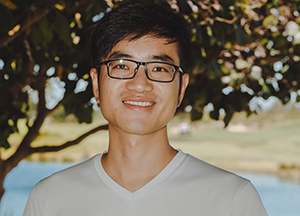
Dr Qingdong Ou, Monash University
Polaritons, hybrid light-matter excitations, enable nanoscale control of light. Particularly large polariton field confinement and long lifetimes can be found in graphene and 2D van der Waals materials, opening new avenues for low-loss photonic applications. Here, we present our recent progress in the engineering of these nanoscale polaritons in anisotropic 2D materials [1]. The observation of anisotropic and ultra-low-loss polariton propagation along the surface of natural 2D material α-MoO3 will be first introduced, which shows phonon polaritons with elliptic and hyperbolic in-plane dispersion [2]. To better utilize the low-loss directional polaritons, we developed a chemical intercalation method to reversibly control and switch the phonon polaritons [3] . Spatially controlled polariton switching was achieved with various in-plane heterostructure configurations and patterns. Very recently, we show how the hyperbolic polaritons in α-MoO3 thin slabs were delicately manipulated by controlling the interlayer twist angle [4].
We experimentally observed tunable topological transitions from open (hyperbolic) to closed (elliptical) dispersion contours in twisted α-MoO3 bilayers at a photonic magic twist angle. The theoretical analysis showed these transitions of in-plane hyperbolic polaritons are controlled by a topological quantity. At the transitions, the photonic dispersion of the resulting topological polaritons flattens, exhibiting low-loss tunable polariton canalization and diffractionless propagation. We envision such natural anisotropic 2D materials offer an unprecedented platform for controlling the flow of energy at the nanoscale.
[1] Dai, Z.; Hu, G.; Ou, Q.; et al., Chem. Rev. 2020, 120, 6197.[2] Ma, W.; Alonso-González, P.; Li, S; et al., Nature 2018, 562, 557.
[3] Wu, Y.; Ou, Q.; Yin, Y.; et al., Nat. Comm. 2020, 11, 2646.
[4] Hu, G.; Ou, Q.; Si, G.; et al., Nature, 2020, 582, 209.
About the presenter
Qingdong Ou is a research fellow working with Prof Michael Fuhrer at Monash University to study nano-device fabrication based on 2D materials, within FLEET’s Enabling technology B. Qingdong is seeking to minimize energy losses in light-matter interactions, aiming to realise ultra-low energy consumption in 2D-semiconductor-based optoelectronics. He also studies carrier behaviour via microscale photoluminescence and photocurrent mapping, and studies highly-confined polaritons in 2D materials using near-field optical nano-imaging within FLEET’s Research theme 2.
